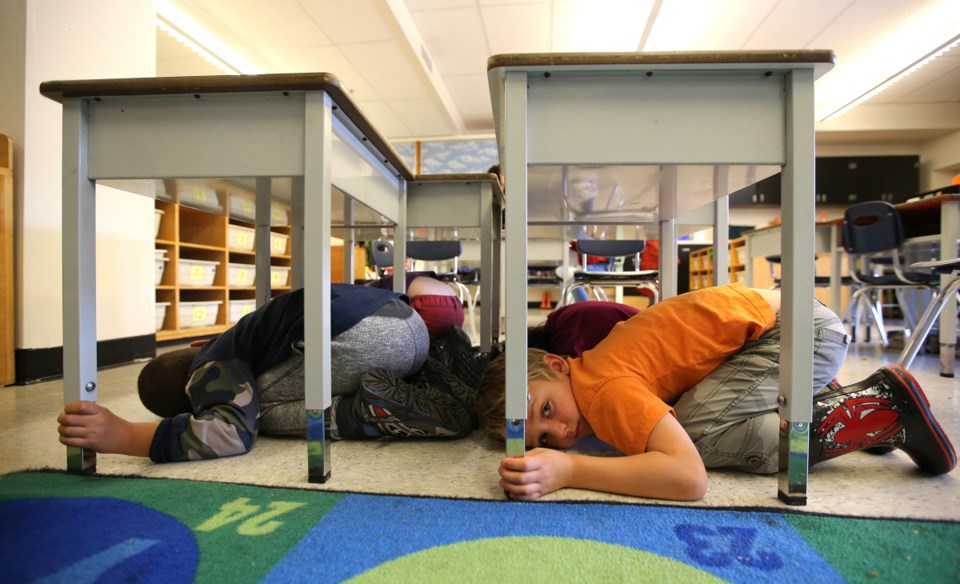Hundreds of thousands of people are set to take place in the province’s largest earthquake drill this morning, as authorities attempt to shake people out of complacency toward the Big One.
The Great British Columbia ShakeOut “drop, cover and hold on” exercise is starts at 10:20 a.m. and lasts for two minutes.
Last year, more than 770,000 people signed up to participate, making it the largest earthquake drill in Canadian history. The B.C. government hopes this year’s numbers top that.
Naomi Yamamoto, the minister of state for emergency preparedness, said the province has made progress since 2014, when a report by then-auditor general Russ Jones found that B.C.’s emergency management agency was inadequately prepared for a catastrophic earthquake.
Since Yamamoto was appointed to the new portfolio in 2015, her department has created the B.C. Earthquake Immediate Response plan and launched an earthquake training program called Master of Disaster for Grade 6 students.
“We’re engaged in a public campaign to increase the awareness of the importance of being prepared,” Yamamoto said.
“It begins in every home with an emergency kit, having a family evacuation plan and a family reunification plan.”
In June, 60 organizations and 600 participants simulated a response to a 9.0 earthquake during a four-day drill in Port Alberni. The exercise was the largest of its kind in Western Canada and cost the B.C. government $1.2 million.
Many students in the region will be taking cover under desks as part of today’s drill, but Quadra Elementary is going a step further with a “reunification” exercise designed to simulate parents arriving to pick up their children after an earthquake.
Greater Victoria school district superintendent Piet Langstraat said the ShakeOut provides a good opportunity to show students the importance of being prepared. He said the Quadra Elementary initiative will cover a vital step.
In the case of a major earthquake, “our duty is very much to look after the safety of our students,” he said. “But all of our typical dismissals [procedures] and all of that are, obviously, going to go up in smoke.”
During the exercise, parents will go through a process to reunite them with their children in the event of an emergency.
The exercise, which will run from 2 p.m. to the regular dismissal time of 2:53 p.m., will also involve municipalities and emergency services, Langstraat said.
“It’s the parents and the staff at Quadra that actually have made this happen,” he said.
“I think it’s going to illustrate the things that are going well, but also the areas where we, as a community, need to improve.”
All classes in the Sooke school district will be taking part in the ShakeOut, said superintendent Jim Cambridge, noting that this year’s ShakeOut comes just as work has finished on an $11-million seismic refit at Dunsmuir Middle School.
The government has promised to carry out seismic upgrades on 339 schools across the province. To date, 115 schools have been completed, but the government has pushed back its deadline for completion to 2025 for most schools across B.C. and to 2030 for Vancouver.
The Greater Victoria school district has completed 15 of its 24 seismic projects. Four schools are currently under construction.
Gord Byers, who runs earthquake preparedness seminars, said one only needs to look at the devastation in Fukushima, Japan, and Christchurch, New Zealand, to be pushed into taking better precautions.
“We’re woefully ill prepared on all fronts,” he said.
Byers said people should have an earthquake kit that would allow self-sufficiency for three days. The kit, which should be kept close to the front door, should include food, water, warm clothes, medical supplies, flashlights, batteries and a hand-crank emergency power charger.
If earthquake insurance is any measure of how seriously people take the threat of a quake, consider that about 70 per cent of people in Greater Victoria and other high-risk areas of the Island have it, compared with just 45 per cent across B.C.
“The biggest thing customers tell us, the reason they don’t purchase earthquake insurance is they don’t think an earthquake is going to happen in their lifetime,” said Insurance Bureau of Canada spokesman Aaron Sutherland.
“That’s something we have to change. We have to get it into their minds that the risk is real and the impact will be massive.”
Preparing for a quake
• Have a plan: Draft a family emergency plan outlining how you’ll respond during an earthquake, especially if you’re separated.
• Build an emergency kit: Stock enough food, water and emergency supplies to sustain you for a minimum of three days. Longer is better.
• Create grab-and-go bags: You might not be at home, so have emergency kits for your vehicle and workplace.
• Seismically secure your home and workplace: Identify items that may topple. Secure heavy furniture to wall studs.
In a quake
• Drop to the ground.
• Take cover by getting under a sturdy desk or table.
• Hold on to it until the shaking stops.
— Source: shakeoutbc.ca



